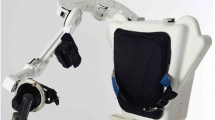Abstract
Robotic Neuro Rehabilitation has been proved to be effective for motor recovery and less demanding for therapists. During a therapy, the aim of the task is to maximize the patient’s effort with respect to his/her clinical status and motor abilities, improving at the same time his/her impaired movements. In this paper, we propose a framework for performance evaluation of post-stroke subjects able to provide assistance-as-needed based on their motor skills during a therapy session with an upper-limb robotic exoskeleton.
Access this chapter
Tax calculation will be finalised at checkout
Purchases are for personal use only
Similar content being viewed by others

References
C. Bütefisch, H. Hummelsheim, P. Denzler, K.-H. Mauritz, Repetitive training of isolated movements improves the outcome of motor rehabilitation of the centrally paretic hand. J. Neurol. Sci. 130(1), 59–68 (1995)
G. Kwakkel, R.C. Wagenaar, J.W. Twisk, G.J. Lankhorst, J.C. Koetsier, Intensity of leg and arm training after primary middle-cerebral-artery stroke: a randomised trial. Lancet 354(9174), 191–196 (1999)
A. Sunderland, D. Tinson, E. Bradley, D. Fletcher, R.L. Hewer, D. Wade, Enhanced physical therapy improves recovery of arm function after stroke. A randomised controlled trial. J. Neurol. Neurosurg. Psychiatry 55(7), 530–535 (1992)
M. Bergamasco, A. Frisoli, M. Fontana, C. Loconsole, D. Leonardis, M. Troncossi, M.M. Foumashi, V. Parenti-Castelli, Preliminary results of bravo project: brain computer interfaces for robotic enhanced action in visuo-motor tasks, in IEEE International Conference on Rehabilitation Robotics (ICORR), 2011 (IEEE, 2011), pp. 1–7
C. Loconsole, F. Stroppa, V. Bevilacqua, A. Frisoli, A robust real-time 3d tracking approach for assisted object grasping, in Haptics: Neuroscience, Devices, Modeling, and Applications (Springer, 2014), pp. 400–408
K. Nykänen, The effectiveness of robot-aided upper limb therapy in stroke rehabilitation: a systematic review of randomized controlled studies (2010)
H.I. Krebs, M. Krams, D.K. Agrafiotis, A. DiBernardo, J.C. Chavez, G.S. Littman, E. Yang, G. Byttebier, L. Dipietro, A. Rykman et al., Robotic measurement of arm movements after stroke establishes biomarkers of motor recovery. Stroke 45(1), 200–204 (2014)
R. Colombo, I. Sterpi, A. Mazzone, C. Delconte, F. Pisano, Taking a lesson from patients’ recovery strategies to optimize training during robot-aided rehabilitation. IEEE Trans. Neural Syst. Rehabil. Eng. 20(3), 276–285 (2012)
E. Pirondini, M. Coscia, S. Marcheschi, G. Roas, F. Salsedo, A. Frisoli, M. Bergamasco, S. Micera, Evaluation of a new exoskeleton for upper limb post-stroke neuro-rehabilitation: Preliminary results, in Replace, Repair, Restore, Relieve–Bridging Clinical and Engineering Solutions in Neurorehabilitation (Springer, 2014), pp. 637–645
Acknowledgments
This work has been partially supported by RONDA project funded by Regione Toscana, Italy, within the FAS ‘Salute’ 2014 program.
Author information
Authors and Affiliations
Corresponding author
Editor information
Editors and Affiliations
Rights and permissions
Copyright information
© 2017 Springer International Publishing AG
About this paper
Cite this paper
Stroppa, F., Loconsole, C., Marcheschi, S., Frisoli, A. (2017). A Robot-Assisted Neuro-Rehabilitation System for Post-Stroke Patients’ Motor Skill Evaluation with ALEx Exoskeleton. In: Ibáñez, J., González-Vargas, J., Azorín, J., Akay, M., Pons, J. (eds) Converging Clinical and Engineering Research on Neurorehabilitation II. Biosystems & Biorobotics, vol 15. Springer, Cham. https://doi.org/10.1007/978-3-319-46669-9_83
Download citation
DOI: https://doi.org/10.1007/978-3-319-46669-9_83
Published:
Publisher Name: Springer, Cham
Print ISBN: 978-3-319-46668-2
Online ISBN: 978-3-319-46669-9
eBook Packages: EngineeringEngineering (R0)



